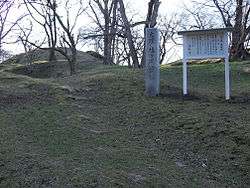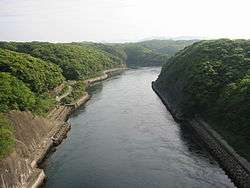List of Historic Sites of Japan (Hokkaido)
This list is of the Historic Sites of Japan located within the Circuit of Hokkaidō.[1]
National Historic Sites
As of 1 July 2014, fifty-two sites have been designated as being of national significance (including one *Special Historic Site).[2][3][4][5]
Prefectural Historic Sites
As of 1 May 2014, twenty-six sites have been designated as being of prefectural importance.[4][14][15]
| Site | Municipality | Comments | Image | Coordinates | Type | Ref. |
|---|---|---|---|---|---|---|
| Kobui Blast Furnace Site 古武井熔鉱炉跡 Kobui yōkōro ato | Hakodate | 41°47′38″N 141°05′56″E / 41.793816°N 141.098775°E | ||||
| Menagawa Brick Mill Site 女那川煉瓦製造所跡 Menagawa renga seizōjo ato | Hakodate | 41°45′44″N 141°04′31″E / 41.762349°N 141.075225°E | ||||
| Esan Shell Mound 恵山貝塚 Esan kaizuka | Hakodate | 41°47′37″N 141°09′12″E / 41.793688°N 141.153288°E | ||||
| Ippongi Triangulation Base 開拓史三角測量一本木基点 kaitaku-shi sankaku-sokuryō-Ippongi kiten | Hokuto | 41°50′10″N 140°39′43″E / 41.836124°N 140.661950°E | ||||
| Aonae Dune Site 青苗砂丘遺跡 Aonae sakyū iseki | Okushiri | 42°03′56″N 139°27′10″E / 42.065575°N 139.452703°E | ||||
| Iwanai Higashiyama Cylinder Culture Site 岩内東山円筒文化遺跡 Iwanai Higashiyama entō bunka iseki | Iwanai | 42°59′00″N 140°31′34″E / 42.983381°N 140.526145°E | ||||
| Mount Jichin Stone Circle 地鎮山環状列石 Jichin-yama kanjō-resseki | Otaru | 43°11′49″N 140°52′18″E / 43.197026°N 140.871538°E | ||||
| Mount Nishizaki Stone Circle 西崎山環状列石 Nishizaki-yama kanjō-resseki | Yoichi | 43°11′24″N 140°50′46″E / 43.190030°N 140.846046°E | ||||
| Nokanan Burial Mounds 野花南周堤墓群 Nokanan shūtei bogun | Ashibetsu | 43°28′08″N 142°16′06″E / 43.468992°N 142.268357°E | ||||
| Kamui Kotan Pit Dwelling Site 神居古潭竪穴住居遺跡 Kamui Kotan tateana jūkyo iseki | Asahikawa | 43°43′31″N 142°11′14″E / 43.725336°N 142.187119°E | ||||
| Gokoku-ji Site 宗谷の護国寺跡 Sōya Gokokuji ato | Wakkanai | 45°29′06″N 141°53′01″E / 45.485049°N 141.883492°E | ||||
| Hamatonbetsu Lake Kutcharo Pit Group 浜頓別クッチャロ湖畔竪穴群 Hamatonbetsu Kutcharo-ko hotori tateana-gun | Hamatonbetsu | 45°07′31″N 142°20′50″E / 45.125231°N 142.347150°E | ||||
| Okoppe Toyono Pit Dwelling Site 興部豊野竪穴住居跡 Okoppe Toyono tateana jūkyo ato | Okoppe | 44°27′35″N 143°10′02″E / 44.459860°N 143.167123°E | ||||
| Shari Burial Mounds 斜里朱円周堤墓群 Shari shuen shūtei bogun | Shari | 43°54′45″N 144°40′03″E / 43.912533°N 144.667593°E | ||||
| Shari Pit Dwelling Sites 朱円竪穴住居跡群 shuen tateana jūkyo ato-gun | Shari | 43°55′01″N 144°45′23″E / 43.916938°N 144.756289°E | ||||
| Omusaro Plateau Pit Group オムサロ台地竪穴群 Omusaro daichi tateana-gun | Monbetsu | 44°23′23″N 143°16′57″E / 44.389697°N 143.282404°E | ||||
| Shibunotsunai Pit Dwelling Site シブノツナイ竪穴住居跡 Shibunotsunai tateana jūkyo ato | Yūbetsu | 44°14′43″N 143°33′45″E / 44.245199°N 143.562384°E | ||||
| Yūfutsu Triangulation Base 開拓使三角測量勇払基点 kaitaku-shi sankaku-sokuryō Yūfutsu-kiten | Tomakomai | 42°37′55″N 141°43′54″E / 42.632001°N 141.731744°E | ||||
| Mukawa Tomb Cluster 鵡川盛土墳墓群 Mukawa moritsuchi funbo-gun | Mukawa | 42°33′45″N 141°56′32″E / 42.562611°N 141.942319°E | ||||
| Shizunai Mount Goten Tomb Cluster 静内御殿山墳墓群 Shizunai Goten-yama funbo-gun | Shinhidaka | 42°22′09″N 142°23′37″E / 42.369222°N 142.393595°E | ||||
| Monbetsu Tomihito Family Graves 門別富仁家噴墓群 Monbetsu Tomihito-ke funbo-gun | Hidaka | 42°28′48″N 142°04′24″E / 42.479915°N 142.073339°E | ||||
| Urahoro Shinyoshino Plateau Stone Tool Site 浦幌新吉野台細石器遺跡 Urahoro Shinyoshino-dai hoso-sekki iseki | Urahoro | 42°46′07″N 143°37′24″E / 42.768628°N 143.623281°E | ||||
| Tokachi Okoppe Site 十勝オコッペ遺跡 Tokachi Okoppe iseki | Urahoro | 42°47′04″N 143°47′13″E / 42.784441°N 143.787003°E | ||||
| Tokachi Buto Sites 十勝太遺跡群 Tokachi Buto iseki-gun | Urahoro | 42°45′40″N 143°41′08″E / 42.761035°N 143.685594°E | ||||
| Tokachi Horokayantō Pit Group 十勝ホロカヤントー竪穴群 Tokachi Horokayantō tateana-gun | Taiki | 42°32′40″N 143°29′26″E / 42.544544°N 143.490672°E | ||||
| Akkeshi Kamuiwa Chashi and Pit Group 厚岸神岩砦跡及び竪穴群 Akkeshi Kamuiwa chashi ato oyobi tateana-gun | Akkeshi | 43°04′09″N 144°52′57″E / 43.069139°N 144.882631°E | ||||
Municipal Historic Sites
As of 1 May 2014, a further one hundred and seventy-nine sites have been designated as being of municipal importance.[16][17][18]
See also
- Cultural Properties of Japan
- List of Places of Scenic Beauty of Japan (Hokkaidō)
- List of Cultural Properties of Japan - paintings (Hokkaidō)
References
| Wikimedia Commons has media related to National historic sites in Hokkaido prefecture. |
- ↑ "Cultural Properties for Future Generations". Agency for Cultural Affairs. Retrieved 30 July 2014.
- ↑ 史跡名勝天然記念物 [Number of Monuments of Japan by Prefecture] (in Japanese). Agency for Cultural Affairs. 1 July 2014. Retrieved 30 July 2014.
- ↑ "Database of National Cultural Properties: 史跡名勝天然記念物 (史跡, 特別史跡 北海道)" (in Japanese). Agency for Cultural Affairs. Retrieved 30 July 2014.
- 1 2 3 4 5 6 道内の指定文化財件数一覧 [Number of Cultural Properties of Hokkaidō] (in Japanese). Hokkaidō. 31 March 2014. Retrieved 30 July 2014.
- ↑ 国の指定・選定文化財一覧 [List of National Cultural Properties of Hokkaidō] (in Japanese). Hokkaidō. Retrieved 30 July 2014.
- ↑ オタフンベチャシ跡 [Otafunbe Chashi Site] (in Japanese). Urahoro Town. Retrieved 21 June 2012.
- ↑ フゴッペ洞窟 [Fugoppe Cave] (in Japanese). Yoichi Town. Retrieved 21 June 2012.
- ↑ フゴッペ洞窟 [Fugoppe Cave] (in Japanese). Agency for Cultural Affairs. Retrieved 21 June 2012.
- 1 2 Hudson, Mark (17 August 2003). "Japan's Cave Art: Mystery cloaks Hokkaido motifs". The Japan Times. Retrieved 21 June 2012.
- ↑ 旧下ヨイチ運上家 [Former Lower Yoichi Duty House] (in Japanese). Agency for Cultural Affairs. Retrieved 21 June 2012.
- ↑ Irish, Ann B (2009). Hokkaido: A History of Ethnic Transition and Development on Japan's Northern Island. McFarland. pp. 119 ff. ISBN 978-0-786-44449-6.
- ↑ 志苔館跡 [Shinori Fortified Residence Site] (in Japanese). Hakodate City. Retrieved 21 June 2012.
- 1 2 3 4 "Jômon Archaeological Sites in Hokkaidô, Northern Tôhoku, and other regions". UNESCO. Retrieved 22 June 2012.
- ↑ 都道府県別指定等文化財件数(都道府県分) [Number of Prefectural Cultural Properties by Prefecture] (in Japanese). Agency for Cultural Affairs. 1 May 2014. Retrieved 30 July 2014.
- ↑ 北海道指定の文化財一覧 [List of Prefectural Cultural Properties of Hokkaidō] (in Japanese). Hokkaidō. Retrieved 30 July 2014.
- ↑ 都道府県別指定等文化財件数(市町村分) [Number of Municipal Cultural Properties by Prefecture] (in Japanese). Agency for Cultural Affairs. 1 May 2014. Retrieved 30 July 2014.
- ↑ 市町村指定文化財の総括表(平成24年4月1日現在) [Number of Municipal Cultural Properties by Municipality] (PDF) (in Japanese). Hokkaidō. 1 April 2012. Retrieved 30 July 2014.
- ↑ 市町村指定文化財一覧 [List of Municipal Cultural Properties of Hokkaidō] (PDF) (in Japanese). Hokkaidō. 1 April 2012. Retrieved 30 July 2014.
External links
- (Japanese) Cultural Properties of Hokkaidō
- (Japanese) List of National Cultural Properties of Hokkaidō
- (Japanese) List of Prefectural Cultural Properties of Hokkaidō
- (Japanese) List of Municipal Cultural Properties of Hokkaidō
This article is issued from Wikipedia - version of the 11/6/2016. The text is available under the Creative Commons Attribution/Share Alike but additional terms may apply for the media files.















